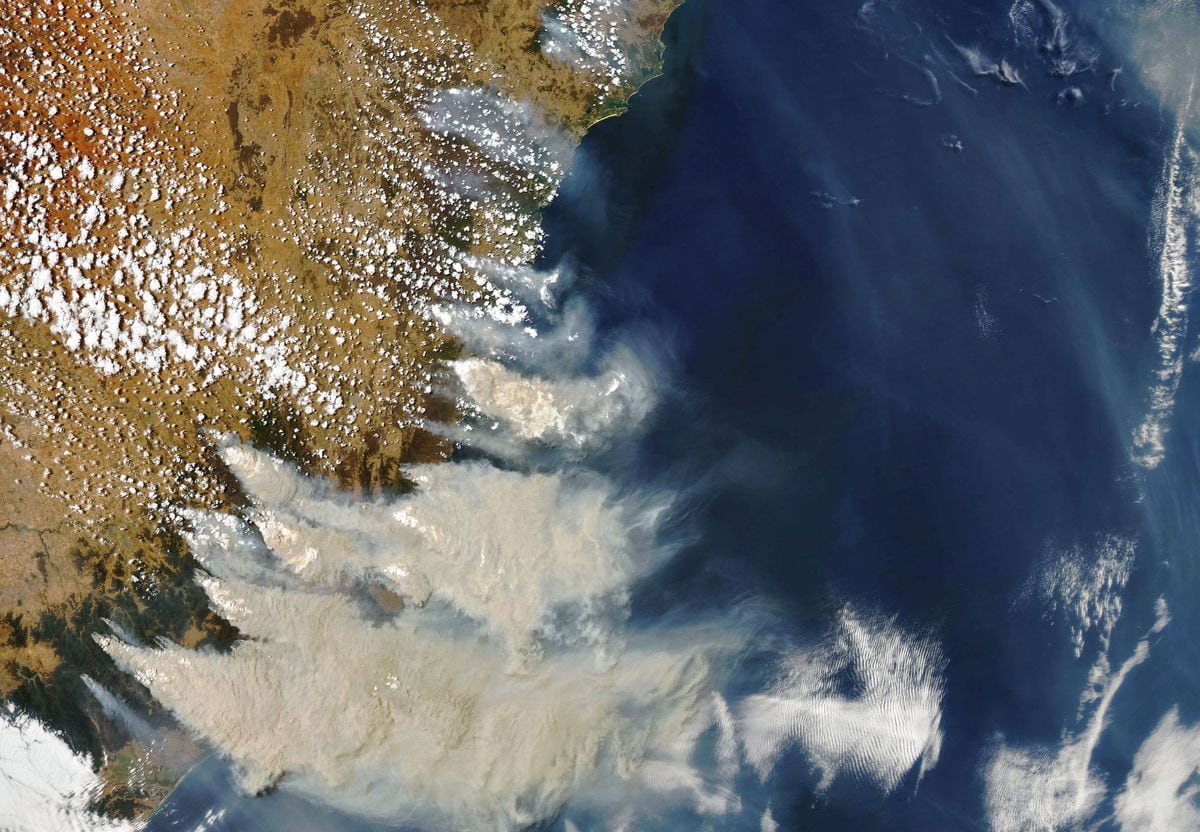Life on Earth develops in the troposphere, the lower layer of the atmosphere where oxygen (O2) abounds, which living beings breathe.
But above is the stratosphere, rich in ozone (O3), which acts as a filter for ultraviolet radiation.
Without this compound, life would not be possible.
Now, a group of scientists has discovered that the smoke from the fires combines with other gases generated by humans to destroy this ozone.
Following the 2019-2020 summer fires in Australia, the hole in this filter was enlarged by 10%.
If it were a global phenomenon, the mega-fires in California, northern Canada, Chile, the Indonesian jungles, Siberia or the incendiary waves in the Mediterranean, would be weakening the atmospheric protection that makes this planet a good place to live.
Throughout its geological evolution, perhaps by simple chance, a mechanism emerged on Earth that protects the planet from ultraviolet (UV) rays, especially those of type B and C, which have the greatest potential for cellular and genetic damage.
This mechanism, in its simplified version, involves oxygen molecules (O₂), formed by two atomic oxygen atoms, O).
Its exposure to UV radiation breaks down the O₂ molecules into O atoms. These then join other O₂ molecules to form O₃, that is, ozone.
Its molecules absorb solar radiation until they are exhausted and then decompose into oxygen and start again.
This is how it has been for millions and millions of years.
But barely a century ago,
Freon was the first of the many chlorofluorocarbons (CFCs) on which the democratization of refrigerators was based first, and that of air conditioning and spray containers later.
Several decades later, the Mexican Mario Molina demonstrated in 1974 that CFCs were rising into the stratosphere and were opening a hole in the ozone layer.
Under the action of radiation, the chlorine in these gases becomes highly reactive and, in a geometric progression, decomposes ozone into oxygen.
The alarm was such that in 1987, the Montreal protocol prohibited the use of CFCs.
The bad thing is that these remain for decades in the stratosphere.
The good thing is that five years ago the ozone layer was recovering.
But fires could burn this recovery.
The fires of the southern summer of 2019 and 2020 threw some 900,000 tons of smoke into the atmosphere, with particles that are associated with chlorine that destroys ozone.EVAN COLLIS/DFES HANDOUT (EFE)
After years of recovery, the Antarctic ozone hole weakened like never before in 2020. Most scientists thought it was the exception to the trend.
But Susan Solomon, an atmospheric chemist at the Massachusetts Institute of Technology (MIT) and other colleagues, didn't buy the anomaly.
At the same time that stratospheric ozone depletion was taking place in most of the southern hemisphere, there were extraordinarily low levels of hydrochloric acid and historically high levels of chlorine monoxide.
Hydrochloric acid (HCl) present in the stratosphere comes from the breakdown of CFCs that humans have emitted for nearly a century.
In principle, the chlorine it contains is not reactive, unless it is released and, in contact with oxygen, turns into chlorine monoxide, the true killer of ozone.
Until now it was known that HCl (known by many as strong water or salfuman) interacted with cloud particles and radiation, decomposing into chlorine monoxide (ClO₂) or atomic chlorine (Cl).
Before these revert to hydrochloric acid, they will have destroyed 1,000 ozone molecules.
But such a reaction occurred under thermal and radiation conditions whose optimum occurs in the stratosphere of the polar regions.
That is why the hole in the ozone layer opens in the Antarctic and occasionally in the Arctic,
but not in the rest of the planet.
But now it is cracking in other parts of the globe as well, according to what Solomon and his colleagues publish in the journal Nature.
“The fact that HCl dropped to unprecedented levels in the mid-latitudes was a warning to me that something serious was up,” Solomon says.
The chemical levels in the stratosphere didn't add up.
They were missing an element, something to add to the equation.
And they thought that the smoke from the fires might hide the answer.
In the months immediately preceding the annual depletion of the ozone layer, Australia experienced a horrific wave of fires that ripped through 30 million hectares, killing more than a billion living things and spewing nearly a million tons into the atmosphere. of smoke.
These particles, thirty kilometers high, were rich in organic carbon.
In principle, carbon is not reactive.
“It is a brutal shock for scientists who study the stratosphere.
No one expected the fires to produce such an effect."
Susan Solomon, an atmospheric chemist at the Massachusetts Institute of Technology (MIT)
After rummaging through chemistry books and studies, they found that hydrochloric acid from CFCs is soluble in a wide group of organic compounds that are carbon-based and, what is worse, at temperatures that occur in the stratosphere of the middle latitudes.
The pieces were beginning to fit together.
“How it works is very simple,” Solomon explains in an email.
“Organic carbon ends up in compounds like alcohols and organic acids.
Everyone knows that alcohol is a great solvent, maybe you have used it for cleaning once.
The organic acids and alcohols in the particles cause them to react with hydrochloric acid at temperatures much warmer than would normally occur in the stratosphere.
Finally,
reactions occur on the surface of the smoke particles that release the chlorine that destroys ozone.
The process is the same as what happens at the poles, "but only at much colder temperatures, because polar stratospheric clouds don't have as high a solubility until they get very cold," Solomon adds.
“This is the new key.
It is a brutal shock for scientists who study the stratosphere.
Nobody expected that the fires would produce such an effect”, concludes the American scientist.
Solomon is not new to this.
He has already discovered that the particles (mainly sulfates, sulfur) released by the huge eruption of the Pinatubo volcano in the Philippines in 1991 not only cooled the planet by at least half a degree over the next two years, but for months weakened the layer of ozone.
Now, the results of his experiments, compared with data from three satellites (which see what is happening in the stratosphere from above) show that the thickness of this protective layer shrank between 3% and 5% in most of the southern hemisphere.
Like every spring, the ozone layer over Antarctica also thinned in 2020. But that year, it did so by 10% more and the hole occupied an additional 2 million square kilometers.
“It is very relevant, and it will be even more so as megafires become more frequent in the coming years due to climate change”
V. Faye McNeill, an expert in atmospheric chemistry and particle physics at Columbia University, United States
For V. Faye McNeill, an expert in the chemistry and physics of atmospheric particles at Columbia University (United States), Solomon's work may have great implications.
“As we have observed many times, even with the Pinatubo volcanic eruption, when the particles reach the stratosphere, they can be transported around the globe and have a global effect on climate and ozone chemistry.”
And now it has been discovered that these aerosols can come from fires.
"It's very relevant, and it will be even more so as megafires become more frequent in the coming years due to climate change," recalls McNeill.
The entry of fires into the equation could help explain many things.
It could help explain, for example, that while the ozone hole is closing over Antarctica, over other parts of the planet the layer is weakening without scientists being clear about the causes.
It could also shed light on what scientists aboard the German icebreaker
Polarstern observed.
during the MOSAIC expedition.
They sailed through the Arctic during the winter and spring of 2019-20 until the ice trapped the ship and they let themselves be carried away by the cap while studying the atmosphere with LIDAR, a laser-based detection system that is bringing much joy to the science.
By bouncing the spectrum of light off particles in the stratosphere, they expected to find a narrow layer of particles of volcanic origin.
But, as they published in a scientific journal, what they found was a thick strip about 10 kilometers high made up mostly of organic compounds.
They could only come from the wave of fires that burned Siberia the previous summer.
If Solomon's discovery were global, all this would fit with the largest hole in the ozone layer over the Arctic ever recorded.
In 2020 there were also mega-fires in Siberia, and in 2021 in Canada and, almost every summer, in Western America, in the Mediterranean, Chile and again in Australia.
You can follow
MATERIA
on
,
and
, or sign up here to receive
our weekly newsletter
.


/cloudfront-eu-central-1.images.arcpublishing.com/prisa/KAZHWIUCH5FM5JORPAPL5JTWWE.jpg)



